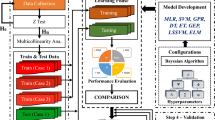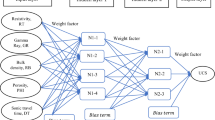Abstract
To accurately estimate the rock shear strength parameters of cohesion (C) and friction angle (φ), triaxial tests must be carried out at different stress levels so that a failure envelope can be obtained to be linearized. However, this involves a higher budget and time requirements that are often unavailable at the early stage of a project. To address this problem, faster and more inexpensive indirect techniques such as artificial intelligence algorithms are under development. This paper first aims to utilize four machine learning techniques of Gaussian process regression (GPR), support vector regression (SVR), decision trees (DT), and long-short term memory (LSTM) to develop a predictive model to estimate parameters C and φ. To this aim, 244 datasets are available in the RockData software for intact Sandstone, including three input parameters of uniaxial compressive strength (UCS), uniaxial tensile strength (UTS), and confining stress (σ3) are employed in the models. The dropout technique is used to overcome the overfitting problem in LSTM-based models. A comprehensive evaluation is adopted for the performance indices of the prediction models. In this step, the most accurate results are produced by the LSTM model (C: R2 = 0.9842; RMSE = 1.295; MAPE = 0.009/φ: R2 = 0.8543; RMSE = 1.857; MAPE = 1.4301). In the second step, we improve the performance of the proposed LSTM model by fine-tuning the LSTM hyper-parameters, using six metaheuristic algorithms of grey wolf optimization (GWO), particle swarm optimization (PSO), social spider optimization (SSO), sine cosine algorithm (SCA), multiverse optimization (MVO), and moth flame optimization (MFO). The developed models' prediction performance for predicting parameter C from high to low was PSO-LSTM, GWO-LSTM, MVO-LSTM, MFO-LSTM, SCA-LSTM SSO-LSTM, and LSTM with ranking scores of 34, 29, 24, 21, 14, 12, and 5, respectively. Also, the models' prediction performance for predicting parameter φ from high to low was PSO-LSTM, GWO-LSTM, MVO-LSTM, MFO-LSTM, SCA-LSTM SSO-LSTM, and LSTM with ranking scores of 34, 31, 23, 18, 15, 14, and 5, respectively. However, the most robust results are produced by the PSO-LSTM model. Finally, the results indicate that applying a metaheuristic algorithm to tune the hyper-parameters of the LSTM model can significantly improve the prediction results. In the last step, the mutual information test method is applied to sensitivity analysis of the input parameters to predict parameters C and φ. Finally, it is revealed that parameters σ3 and UCS have the highest and lowest impact on the parameters C and φ, respectively.
Highlights
-
Employing a large dataset consists of 244 data.
-
Using six ML algorithms that most of them had not been tested before for this issue.
-
Applying 5-fold CV to validate the results.
-
Application of feature selection to find the most effective parameters on the water inflow into tunnels.
-
Recognition of the best prediction method.





















Similar content being viewed by others
Abbreviations
- \({\sigma }_{1}\) :
-
Maximum principal stresse
- \({\sigma }_{3}\) :
-
Minimum principal stresse
- \(k\) :
-
An intermediate auxiliary parameter
- \({\sigma }_{{\mathrm{c}}_{i}\_\mathrm{fitted}}\) :
-
Fitted UCS value from regression analysis
- \(N\) :
-
Number of tests
- \({y}_{i}\) :
-
Actual value
- \({y}_{i}^{^{\prime}}\) :
-
Predicted value
- \({\overline{y} }_{i}\) :
-
Mean of actual value
- \({\overline{y} }_{i}^{^{\prime}}\) :
-
Mean of predicted value
- \(\mu \left({x}_{i}\right)\) :
-
Mean
- \(k({x}_{i},{x}_{i})\) :
-
Kernel
- \(S\) :
-
A group of samples that is not separated yet
- \({S}_{\mathrm{t}}\) :
-
A group of separated samples with true result
- \({S}_{\mathrm{f}}\) :
-
A group of separated samples with a false result
References
Adrien R, Patrice R, Laurent P, Pierre B (2020) Influence of roughness on the apparent cohesion of rock joints at low normal stresses. J Geotech Geoenviron Eng 146:04020003. https://doi.org/10.1061/(ASCE)GT.1943-5606.0002200
Awad M, Khanna R (2015) Support vector regression. Efficient learning machines. Apress, Berkeley. https://doi.org/10.1007/978-1-4302-5990-9_4
Beiki M, Majdi A, Givshad AD (2013) Application of genetic programming to predict the uniaxial compressive strength and elastic modulus of carbonate rocks. Int J Rock Mech Min Sci 63:159–169. https://doi.org/10.1016/j.ijrmms.2013.08.004
Beyhan S (2008) The determination of G.L.I and E.L.I marl rock material properties depending on triaxial compressive strength. PhD thesis, Osman Gazi University, 224
Cai M (2010) Practical estimates of tensile strength and hoek-brown strength parameter m i of brittle rocks. Rock Mech Rock Eng 43:167–184. https://doi.org/10.1007/s00603-009-0053-1
Cevik A, Sezer EA, Cabalar AF, Gokceoglu C (2011) Modeling of the uniaxial compressive strength of some clay-bearing rocks using neural network. Appl Soft Comput 11:2587–2594. https://doi.org/10.1016/j.asoc.2010.10.008
Elbaz K, Shen S-L, Zhou A, Yuan D-J, Xu Y-S (2019) Optimization of EPB shield performance with adaptive neuro-fuzzy inference system and genetic algorithm. Appl Sci 9(4):780. https://doi.org/10.3390/app9040780
Farah R (2011) Correlations between index properties and unconfined compressive strength of weathered Ocala Limestone. MSc thesis, University of North Florida School of Engineering, 83
Gokceoglu C (2002) A fuzzy triangular chart to predict the uniaxial compressive strengthof Ankara agglomerates from their petrographic composition. Eng Geol 66:39–51. https://doi.org/10.1016/S0013-7952(02)00023-6
Grima MA, Babuška R (1999) Fuzzy model for the prediction of unconfined compressive strength of rock samples. Int J Rock Mech Min Sci 36:339–349. https://doi.org/10.1016/S0148-9062(99)00007-8
Howarth D, Rowlands J (1986) Development of an index to quantify rock texture for qualitative assessment of intact rock properties. Geotech Test J 9:169–179. https://doi.org/10.1520/GTJ10627J
Jing H, Nikafshan Rad H, Hasanipanah M, Jahed Armaghani D, Qasem SN (2020) Design and implementation of a new tuned hybrid intelligent model to predict the uniaxial compressive strength of the rock using SFS-ANFIS. Eng Comput. https://doi.org/10.1007/s00366-020-00977-1
Kahraman S, Gunaydin O, Alber M, Fener M (2009) Evaluating the strength and deformability properties of Misis fault breccia using artificial neural networks. Expert Syst Appl 36:6874–6878. https://doi.org/10.1016/j.eswa.2008.08.002
Karaman K, Cihangir F, Ercikdi B, Kesimal A, Demirel S (2015) Utilization of the brazilian test for estimating the uniaxial compressive strength and shear strength parameters. J S Afr Inst Min Metall 115:185–192
Kurtulus C, Sertçelik F, Sertçelik I (2018) Estimation of unconfined uniaxial compressive strength using schmidt hardness and ultrasonic pulse velocity. Teh Vjesn 25:1569–1574. https://doi.org/10.17559/TV-20170217110722
Liu XX, Shen SL, Xu YS, Yin ZY (2018) Analytical approach for time-dependent groundwater inflow into shield tunnel face in confined aquifer. Int J Numer Anal Methods Geomech 42:655–673. https://doi.org/10.1002/nag.2760
Mahmoodzadeh A, Zare S (2016) Probabilistic prediction of the expected ground conditions and construction time and costs in road tunnels. J Rock Mech Geotech Eng 8(5):734–745. https://doi.org/10.1016/j.jrmge.2016.07.001
Mahmoodzadeh A, Mohammadi M, Daraei A, Rashid TA, Sherwani AFH, Faraj RH, Darwesh AM (2019) Updating ground conditions and time-cost scatter-gram in tunnels during excavation. Autom Constr 105:102822. https://doi.org/10.1016/j.autcon.2019.04.017
Mahmoodzadeh A, Mohammadi M, Abdulhamid SN, Ibrahim HH, Hama Ali HF, Salim SG (2021a) Dynamic reduction of time and cost uncertainties in tunneling projects. Tunn Undergr Space Technol 109:103774. https://doi.org/10.1016/j.tust.2020.103774
Mahmoodzadeh A, Mohammadi M, Ibrahim HH, Abdulhamid SN, Salim SG, Hama Ali HF, Majeed MK (2021b) Artificial intelligence forecasting models of uniaxial compressive strength. Transp Geotech 27:100499. https://doi.org/10.1016/j.trgeo.2020.100499
Mahmoodzadeh A, Mohammadi M, Hama Ali HF, Abdulhamid SN, Ibrahim HH, Noori KMG (2021c) Dynamic prediction models of rock quality designation in tunneling projects. Transp Geotech 27:100497. https://doi.org/10.1016/j.trgeo.2020.100497
Mahmoodzadeh A, Mohammadi M, Ibrahim HH, Noori KMG, Abdulhamid SN, Hama Ali HF (2021e) Forecasting sidewall displacement of underground caverns using machine learning techniques. Autom Constr 123:103530. https://doi.org/10.1016/j.autcon.2020.103530
Mahmoodzadeh A, Mohammadi M, Daraei A, Faraj RH, Omer RMD, Sherwani AFH (2020a) Decision-making in tunneling using artificial intelligence tools. Tunn Undergr Space Technol. https://doi.org/10.1016/j.tust.2020.103514
Mahmoodzadeh A, Mohammadi M, Daraei A, Hama-Ali HF, Abdullah AI, Al-Salihi NK (2020b) Forecasting tunnel geology, construction time and costs using machine learning methods. Neural Comput Appl. https://doi.org/10.1007/s00521-020-05006-2
Mahmoodzadeh A, Mohammadi M, Daraei A, Hama-Ali HF, Al-Salihi NK, Omer RMD (2020c) Forecasting maximum surface settlement caused by urban tunneling. Autom Constr. https://doi.org/10.1016/j.autcon.2020.103375
Mahmoodzadeh A, Mohammadi M, Ibrahim HH, Rashid TA, Aldalwie AHM, Hama Ali HF, Daraei A (2021d) Tunnel geomechanical parameters prediction using Gaussian process regression. Mach Learn Appl 3:100020. https://doi.org/10.1016/j.mlwa.2021.100020
Miah MI, Ahmed S, Zendehboudi S, Butt S (2020) Machine learning approach to model rock strength: prediction and variable selection with aid of log data. Rock Mech Rock Eng 53:4691–4715. https://doi.org/10.1007/s00603-020-02184-2
Mohammed DA, Alshkane YM, Hamaamin YA (2020) Reliability of empirical equations to predict uniaxial compressive strength of rocks using Schmidt hammer. Georisk 14:308. https://doi.org/10.1080/17499518.2019.1658881
Qiu Y, Zhou J, Khandelwal M, Yang H, Yang P, Li C (2021) Performance evaluation of hybrid WOA-XGBoost, GWO-XGBoost and BO-XGBoost models to predict blast-induced ground vibration. Eng Comput. https://doi.org/10.1007/s00366-021-01393-9
Rezaee M, Mojtahedi SFF, Taherabadi E, Soleymani K, Pejman M (2020) Prediction of shear strength parameters of hydrocarbon contaminated sand based on machine learning methods. Georisk. https://doi.org/10.1080/17499518.2020.1861633
Rocscience (2012) ‘‘RocData’’. http://www.rocscience.com/products/4/RocData. Accessed 10 Sep 2016
Şahin M, Ulusay R, Karakul H (2020) Point load strength index of half-cut core specimens and correlation with uniaxial compressive strength. Rock Mech Rock Eng 53:3745–3760. https://doi.org/10.1007/s00603-020-02137-9
Shen J, Jimenez R (2018) Predicting the shear strength parameters of Sandstone using genetic programming. Bull Eng Geol Environ 77:1647–1662. https://doi.org/10.1007/s10064-017-1023-6
Singh A, Ayothiraman R, Rao KS (2020) Failure criteria for isotropic rocks using a smooth approximation of modified Mohr-Coulomb failure function. Geotech Geol Eng 38:4385–4404. https://doi.org/10.1007/s10706-020-01287-5
Tariq Z, Elkatatny S, Mahmoud M, Abdulwahab ZA, Abdulraheem A (2017) A new approach to predict failure parameters of carbonate rocks using artificial intelligence Tools. Paper presented at the SPE Kingdom of Saudi Arabia Annual Technical Symposium and Exhibition, Dammam, Saudi Arabia. https://doi.org/10.2118/187974-MS
Teymen A (2019) Estimation of Los Angeles abrasion resistance of igneous rocks from mechanical aggregate properties. Bull Eng Geol Environ 78:837–846. https://doi.org/10.1007/s10064-017-1134-0
Ulusay R, Türeli K, Ider MH (1994) Prediction of engineering properties of a selected litharenite sandstone from its petrographic characteristics using correlation and multivariate statistical techniques. Eng Geol 37:135–157. https://doi.org/10.1016/0013-7952(94)90029-9
Vapnik VN (1995) The nature of statistical learning theory. Springer, New York
Verron S, Tiplica T, Kobi A (2008) Fault detection and identification with a new feature selection based on mutual information. J Process Control 18:479–490. https://doi.org/10.1016/j.jprocont.2007.08.003
Yin ZY, Jin YF, Shen SL, Huang HW (2017) An efficient optimization method for identifying parameters of soft structured clay by an enhanced genetic algorithm and elastic viscoplastic model. Acta Geotech 2017(12):849–867. https://doi.org/10.1007/s11440-016-0486-0
Zendehboudi S, Shafiei A, Bahadori A, James LA, Elkamel A, Lohi A (2014) Asphaltene precipitation and deposition in oil reservoirs-Technical aspects, experimental and hybrid neural network predictive tools. Chem Eng Res Des 92:857–875. https://doi.org/10.1016/j.cherd.2013.08.001
Zendehboudi S, Rezaei N, Lohi A (2018) Applications of hybrid models in chemical, petroleum, and energy systems: a systematic review. Appl Energy 228:2539–2566. https://doi.org/10.1016/j.apenergy.2018.06.051
Zhou J, Qiu Y, Jahed Armaghani D, Zhang W, Li C, Zhu S, Tarinejad R (2021) Predicting TBM penetration rate in hard rock condition: a comparative study among six XGB-based metaheuristic techniques. Geosci Front 12:101091. https://doi.org/10.1016/j.gsf.2020.09.020
Author information
Authors and Affiliations
Corresponding author
Ethics declarations
Conflict of interest
There is no conflict of interest.
Additional information
Publisher's Note
Springer Nature remains neutral with regard to jurisdictional claims in published maps and institutional affiliations.
Rights and permissions
About this article
Cite this article
Mahmoodzadeh, A., Mohammadi, M., Ghafoor Salim, S. et al. Machine Learning Techniques to Predict Rock Strength Parameters. Rock Mech Rock Eng 55, 1721–1741 (2022). https://doi.org/10.1007/s00603-021-02747-x
Received:
Accepted:
Published:
Issue Date:
DOI: https://doi.org/10.1007/s00603-021-02747-x




